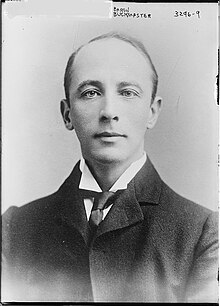Stanley Buckmaster, 1st Viscount Buckmaster
PC | |
|---|---|
 | |
| Lord High Chancellor of Great Britain | |
| In office 25 May 1915 – 5 December 1916 | |
| Prime Minister | H. H. Asquith |
| Preceded by | The Viscount Haldane |
| Succeeded by | The Viscount Finlay |
| Personal details | |
| Born | 9 January 1861 London, England |
| Political party | Liberal |
| Spouse |
Edith Augusta Lewin (m. 1889) |
| Education | Christ Church, Oxford |
Stanley Owen Buckmaster, 1st Viscount Buckmaster,
Background and education
Buckmaster was born on 9 January 1861 to John Charles Buckmaster, of Ashleigh,
Political career
At the 1906 general election, Buckmaster was elected as MP for Cambridge,[3] winning the seat from the Conservatives with a majority of less than 4%. At the
Buckmaster returned to the Commons the following year, when he was elected at a by-election in October 1911 for the safe Liberal seat of Keighley in Yorkshire. He was knighted in 1913 on his appointment as Solicitor general, when he was comfortably re-elected in the ministerial by-election.
He was a Member of the Council of the Duchy of Lancaster and served under H. H. Asquith as Solicitor-General from 1913 to 1915. Buckmaster was also Counsel to the University of Oxford from 1911 to 1913, Director of The Press Bureau, 1914 to 1915, and a member of The Interallied Conference on Finance and Supplies.
Lord Chancellor
In 1915, Asquith was forced to form a
Buckmaster was Lord Chancellor for only eighteen months, resigning alongside Asquith in December 1916. His tenure was largely overshadowed by the war. He only appointed two High Court judges—Peterson and McCardie—and no new King's Counsel, on the grounds that junior barrister engaged in war service would be disadvantaged. Sitting judicially, he gave the decision in Cook v Deeks, a notable company law case. As a member of the Cabinet, he also took part in decision concerning war strategy.
Lord of Appeal
After stepping down from the woolsack, Buckmaster continued to sit judicially as a Lord of Appeal, except for a time when he left his judicial work to go into the City. In Bowman v. Secular Society he held that a company formed for the purpose of challenging Christianity was not illegal. In Donoghue v Stevenson he gave a dissenting opinion against the extension of the duty of care. He was highly regarded as a judge by his colleagues: Lord Birkenhead described him as "a consummate judge" and Lord Dunedin regarded him as the greatest colleague he had on the bench.
He later served as Chairman of the Governing Body of Imperial College of Science and Technology and as Chairman of the Political Honours Review Committee between 1924 and 1929. He was appointed GCVO in 1930 and was made Viscount Buckmaster, of Cheddington in the County of Buckingham, in 1933.
He died on 5 December 1934 in
Family
Buckmaster married Edith Augusta Lewin, daughter of Spencer Robert Lewin, in 1889. Their eldest daughter, the Hon. Margaret Buckmaster (later Pollock), was an author, social reformer and Labour Party activist. Their youngest daughter, the Hon. Barbara Buckmaster (later Miller), was the mother of the Conservative politician Hal Miller. Buckmaster died in London in December 1934, aged 73, and was cremated at Golders Green Crematorium.[4] He was succeeded in his titles by his only son, Owen. Lady Buckmaster died in October 1935. His niece, Hilda Buckmaster was also active in politics, three times standing as a parliamentary candidate for the Liberal Party.
Arms
  |
|
References
- ^ New York Times. 5 December 1934.
- ^ "No. 27424". The London Gazette. 11 April 1902. p. 2416.
- ^ "The city of Cambridge: Parliamentary representation Pages 68-76 A History of the County of Cambridge and the Isle of Ely: Volume 3, the City and University of Cambridge". British History Online. Victoria County History, 1959. Retrieved 26 December 2022.
- ^ The Complete Peerage, Volume XIII - Peerage Creations 1901-1938. St Catherine's Press, London. 1949. p. 201.
- ^ Debrett's Peerage. 2019. p. 1899.
Further reading
For a fuller biography see William Goodhart, ‘Buckmaster, Stanley Owen, first Viscount Buckmaster (1861–1934), Oxford Dictionary of National Biography, Oxford University Press, 2004.

